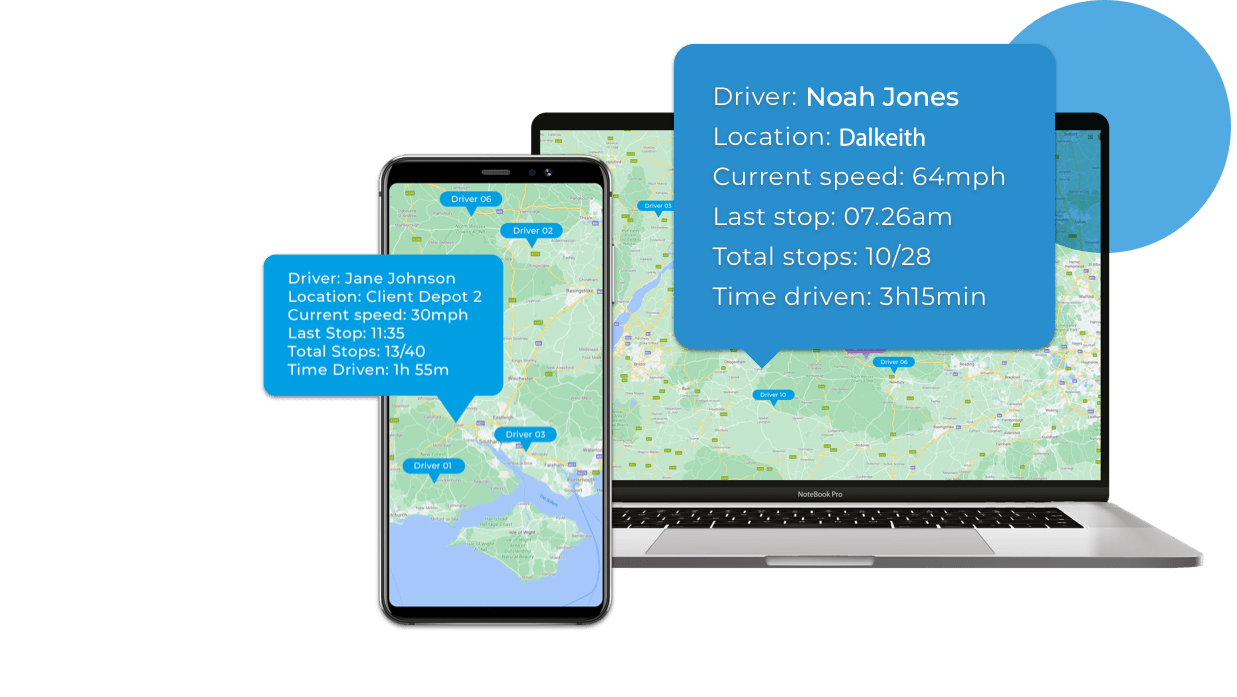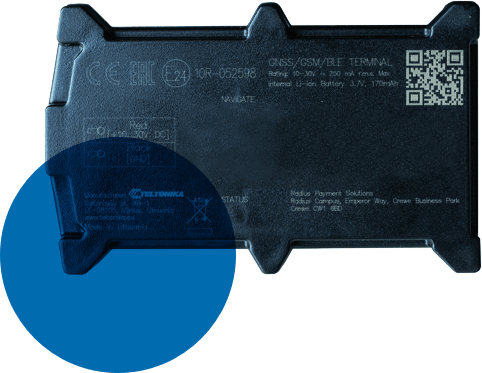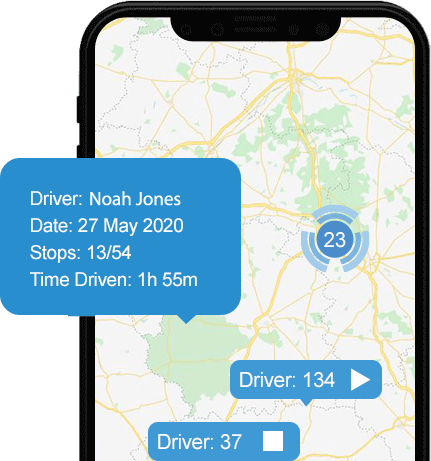Our purpose is to save you time and money. We are experts at scouring the market, sourcing the best deals and passing them on to you.
How iCompario works
About your business
You tell us about your fleet, your business and the types of tracking you need.
The best telematics offers
We compare your needs with the products available and get quotes on the best matches.
Start tracking your fleet
Then we check your details and pass you over to the relevant company to get you started.

Who are we?
iCompario is run by a small team of professionals with industry backgrounds in vehicle tracking, fuel sales, telecoms, financial research, writing and IT which stretch back 25 years. We launched iCompario in 2017 and the original team is still here, but growing fast!

New to vehicle tracking?
Vehicle tracking helps you manage a fleet of any size or type. In a mobile app or browser, you can see where your vehicles are and where they have been, which driver is most likely to raise your insurance premium by having an accident, who wastes fuel by leaving the engine idling, and who takes 2-hour breaks without telling you.
Frequently Asked Questions
Telematics and vehicle tracking are similar. All systems use transmitting devices fitted in vehicles (or moving assets like trailers) and software that interprets the signal into useful information which is presented to them in an app or browser.
The term “vehicle tracking” usually refers to a simple vehicle tracker which transmits a signal showing the location of a vehicle using GPS. It may also have an accelerometer, which can give accurate data on the speed of the vehicle.
The word “telematics” is more often used to describe the more sophisticated systems which can send other types of signals as well. They may include dashboard cameras, in-vehicle cameras and devices which can connect to the CAN bus. These CAN bus telematics systems transmit all sorts of diagnostics and other information about parts of a vehicle being opened, closed or activated.
Telematics black boxes are designed for private individuals rather than businesses.
Telematics insurance, or a “telematics policy”, is personalised car insurance based on your driving style and habits. The telematics box, which can be fitted to your car battery or even just sticks on your windscreen and is solar powered, reports direct to your insurer the way you drive and where you drive.
Various insurers call this black box insurance, smart box insurance, pay as you drive, and usage-based insurance or UBI. The term “black box” was coined because the person with the telematics device in their car doesn’t see the data – it goes straight to the insurer. By contrast, with business telematics, you have the devices in your vehicles and use the information yourself, to manage your fleet.
More and more insurers are offering telematics boxes as a way to lower the cost of car insurance for certain drivers who have a lower probability of making insurance claims. The things which represent lower risk to insurers are driving by day, using motorways and sticking to the speed limit, and these can lead to lower priced insurance. Things which represent higher risks to insurers are driving by night, using twisty lanes and going over the speed limit.
The black box signal goes to telematics software which works out the driver’s scores on these factors, and insurers use these to calculate the driver’s risk of having accidents and therefore the price of their car insurance.
GPS fleet tracking refers to the core functionality of telematics, and it is a part of all telematics systems.
A GPS locator in a vehicle (or other moving asset) sends a secure GPS signal using wireless technology to a secure server. The data is stored and presented to the user in a telematics app or browser software.
The telematics software shows a map with markers which move around in real time. If you have ever shared the location of your mobile phone with another person and seen where they are, you will know what this looks like.
The telematics software also stores up a log of the vehicle’s location so the manager can look back over its moving times, routes and stopping times. Most telematics providers store this data for the previous month on a rolling basis.
The three main benefits of telematics are more efficient fleet management, driver and vehicle safety, and cost savings.
Fleet managers who use telematics can actively manage their drivers by having an eagle-eye view of each vehicle on a map in real time. This means they can immediately see in their telematics software who is the nearest driver to send to the next job, tell the customer how long till they arrive and see exactly how long each driver spends stopped on breaks. The commercial benefits and practical convenience of having this type of visibility of the whole workforce tend to vary from one business type to another.
Managers can improve security for their vehicles by getting automatic app alerts or emails from their telematics system as soon a vehicle goes outside any particular area. This is useful to know if vans or lorries are not supposed to leave the depot outside working hours, for example. Alerts can also let a fleet manager know each time a vehicle reaches a depot, or any other spot he wants to know about, so he can track how long each vehicle spends there. If a vehicle is stolen, a manager can see where it goes. This is also useful to expose if drivers are doing side-jobs using company vans and fuel.
In-vehicle monitoring systems (IVMS) are a function of telematics that track how carefully a driver handles the vehicle, by looking at speeding, rapid acceleration, harsh braking and speedy cornering. These four habits increase wear and tear on parts of the engine, brakes and drive train, meaning time off the road for repairs. They also waste fuel. Using telematics means a manager can identify these habits and save money by putting a stop to them.
The short answer is yes, definitely. Every business is different, but companies that try telematics almost never go back. Once they start using telematics, they do not want to work without it.
The benefits of using telematics do not relate to the size of a company or fleet. They do not always fully correlate to the amount of time vehicles spend driving on the road each day, either. The amount of cash a business can save through using telematics to cut costs will definitely vary depending how much of the functionality it uses. Let’s look at some examples.
If using your telematics system shows that your drivers are taking unauthorised breaks, you can add up the total you are paying them during those breaks over the course of one month. In most cases, it turns out to be more than the cost of the telematics system for the month. This means that using telematics to stamp out the unauthorised breaks is a financial win.
A telematics system with an accelerometer can highlight and measure driving behaviours that waste fuel and put vehicles out of action more often, needing repairs for wear and tear or crash damage. If you add up how many times your business has had a vehicle off the road, and what it cost in payments to the mechanic plus hiring a replacement vehicle, chances are the telematics system can save much more money than it costs. When you add on the cost of lost business and a hike in your fleet insurance price the following year, the financial benefits of using telematics keep growing.
Stamping out risky driving by using a telematics system has the second benefit of reducing your number of insurance claims. This can reduce fleet insurance premiums by as much as 30% if the driving standards and habits are safer across the whole fleet for three years in a row.
Simply using the telematics software functionality that counts up engine idling can save a lot of money spent on fuel. An idling 3.5 tonne vehicle gets through anything from 2 to 5 litres of diesel every hour. Even leaving a small van idling for half an hour a day will waste a full tank of fuel every two months.
So, when is telematics not worth it? It may not bring financial rewards or practical benefits to small companies which very much trust the people who drive their vehicles, already pay low fleet insurance and are working at maximum efficiency in deploying the workforce to get the job done.
The core functionality of any telematics system is locating vehicles. This makes the difference between a fleet manager who is truly in control of his operation, making it as efficient as it can be, and a manager who basically relies on his drivers to manage themselves.
With telematics, a manager gets an eagle-eye view of where every vehicle is, all the time. This makes it easy for him to see who is closest to the next job. A telematics system can highlight roads which often cause delays to drivers at certain times of day. Productivity can improve if the fleet manager tells drivers to use a different route which gets them to their destination faster.
One use of telematics revolves around establishing trust with new employees. Telematics can clarify if there really was a hold-up at the warehouse, for example, or if a driver has taken an unauthorised break to do a side-job of his own using the company van. Companies with lots of drivers or rapid staff turnover find this very useful.
Telematics software also allows the manager to enter a destination, and the system estimates the driver’s time of arrival. This functionality is great for multi-stop delivery fleets or any kind of service company, where customers have to wait at home for someone to arrive. It can give a huge boost to the impression companies give their customers and often improves the customer retention rate.
Imagine a line on a map circling off a particular area, of any shape or size – this imaginary boundary is a geofence.
A digital tachograph or “tacho” is a device fitted in goods and passenger vehicles that exceed a legally specified weight. They are obligatory in many countries to enforce the regulations on how many hours a driver can work in a continuous shift and how many shifts he is permitted to drive before he must have a day off work. The tachograph records various types of driver and vehicle data, including journey distance, speed, driving time and the driver’s break times and other activities. The data from the tachograph is stored in the vehicle unit memory and on driver cards.
Tachographs are used as part of telematics systems to make sure drivers and employers follow the rules on drivers’ working hours. Drivers are not allowed to work shifts longer than a set number of hours, or work continuously without prescribed breaks.
A tachograph is a type of telematics used to check the hours that a driver has worked, when he has taken breaks and so on. It is installed in all vehicles of the relevant weight category and saves data that is checked regularly by an independent agency.
Information from digital tachographs is saved on smart cards so it can be checked later. From some tachograph systems, it can be checked remotely.
There are different types of tachograph card for drivers and haulage companies. Driver cards are used by drivers to record driving, rest and activity information. Control cards are used by law enforcement agencies to retrieve data from the tachograph. Since the information is used to prove that companies and drivers have obeyed the law, the tachograph data or “tacho” output is read by an independent agency, not by the owner of the vehicle.
To use a tachograph, the driver inserts his card and the tachograph records details of all that happens to the vehicle.
The vehicle unit of a tachograph is installed in the driver’s area of the cabin, and there is also a motion or speed sensor on the gearbox. The vehicle unit collects signals from the speed sensor, and records the following data: date, vehicle speed, single or co-driver, number of times a driver card is inserted each day, distance travelled by the driver, driver activity (driving, rest, breaks and other activities) and the date and time of each activity change, events such as speeding, driving without a driver card and attempts to tamper with the tachograph, and details of tachograph calibrations.
The data is regularly checked to make sure that the driving times and driver’s breaks comply with the hours prescribed for safety by law.
To use a tachograph, the driver inserts his card and the tachograph records details of all that happens to the vehicle.
The vehicle unit of a tachograph is installed in the driver’s area of the cabin, and there is also a motion or speed sensor on the gearbox. The vehicle unit collects signals from the speed sensor, and records the following data: date, vehicle speed, single or co-driver, number of times a driver card is inserted each day, distance travelled by the driver, driver activity (driving, rest, breaks and other activities) and the date and time of each activity change, events such as speeding, driving without a driver card and attempts to tamper with the tachograph, and details of tachograph calibrations.
The data is regularly checked to make sure that the driving times and driver’s breaks comply with the hours prescribed for safety by law.



